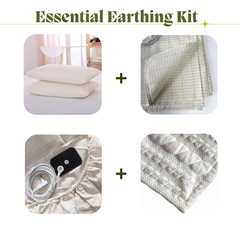Struggling with poor sleep can leave you feeling drained. Bed grounding mat may offer a simple way to improve your rest by mimicking direct contact with the Earth. This blog will explain how these mats work and their potential benefits for better sleep.
Keep reading to discover the specific ways they can help.
Key Takeaways
- Bed grounding mats reduce stress by calming the brain and stabilizing electrical activity, as shown in a 2015 study. This promotes relaxation and helps improve emotional well-being.
- Grounding balances the body’s natural electric charge by connecting to Earth’s negative energy, offsetting positive charges from electronic devices or artificial environments.
- A 2004 study found that grounding aligns cortisol levels with circadian rhythms, helping lower nighttime cortisol spikes for deeper, more restorative sleep.
- Improved circulation from using a grounding mat reduces blood viscosity and enhances heart rate variability (HRV), promoting better recovery during rest periods.
- Studies show grounding reduces inflammation, easing discomfort that disrupts sleep quality while aiding recovery after physical fatigue or exercise-induced soreness.
How Does a Bed Grounding Mat Work?
Best grounding mat connects to the ground port of an electrical outlet or a grounding stake outside. This connection allows electrons from the Earth’s negative electric charge to flow into your body through direct contact with the mat.
These mats replicate earthing, which occurs when you touch the Earth directly, such as walking barefoot on grass.
The mat helps neutralize your body’s positive electric charge by transferring the Earth’s natural energy. It aligns cortisol levels with your circadian rhythm, promoting restorative sleep and reducing stress.
Grounding sheets and mats stabilize this process while supporting relaxation during rest hours.
Specific Ways a Bed Grounding Mat Can Improve Sleep Quality
Best grounding mat for bed helps the body achieve a sense of calm, promoting better rest. It supports physical recovery by aiding natural processes during sleep.
Reduces stress and promotes relaxation
Grounding helps calm the brain by stabilizing electrical activity. Research from 2015 showed that grounding for one hour improved mood and reduced stress levels. This supports its role in promoting relaxation and relieving anxiety.
Using a grounding mat may help alleviate symptoms of depression and support better emotional well-being. It benefits mental health by encouraging natural calming of the brain, which can effectively reduce tension over time.
Balances the body’s natural electrical charge
A grounding mat helps stabilize the body’s natural electrical charge by connecting it to the Earth. The Earth has a negative electric charge, and direct contact allows electrons to flow into the body.
This offsets excess positive charges that can accumulate over time due to exposure to electronic devices or artificial environments.
Balancing the body's electric charge may help reduce disruptions in biological processes related to sleep. Research indicates this connection with Earth's energy supports improved rest and better health.
Using a grounding mat for better sleep fosters harmony between your body and its environment, promoting relaxation while you’re resting.
Lowers cortisol levels for deeper sleep
Grounding has been shown to reduce cortisol levels, the body’s primary stress hormone. A 2004 study found that grounding therapy aligns cortisol patterns with the natural 24-hour circadian rhythm.
This helps decrease nighttime spikes in cortisol, leading to deeper and more restorative sleep.
By reducing stress hormone production, grounding supports faster sleep onset and improves sleep quality. These advantages make it easier for the body to recover during the night. Lowered cortisol also helps maintain a calm nervous system, fostering ideal conditions for uninterrupted rest.
Improves blood circulation during rest
Using best grounding mat during sleep enhances blood flow by reducing blood viscosity. Poor circulation can contribute to health issues like diabetes, heart disease, and hypertension.
Grounding benefits cardiovascular health by allowing the body to balance its electrical charge while resting.
Studies show improved heart rate variability (HRV) after just 20 minutes of grounding. Better HRV reflects efficient circulation and reduced stress on the heart. Regular use of a bed grounding mat facilitates relaxation, which supports natural recovery processes in the body.
Reduces inflammation that disrupts sleep
Bed grounding mats may help reduce inflammation that disrupts sleep. Inflammation in the body can lead to discomfort and restless nights. Grounding therapy allows the body to connect with Earth’s natural energy, which has been linked to anti-inflammatory effects.
This connection helps calm overactive immune responses that trigger chronic inflammation.
Studies on grounding show a significant reduction in markers of inflammation, improving conditions often tied to poor sleep quality. By easing inflammatory pain or swelling, grounding mats create an environment where restful sleep becomes achievable.
These benefits support long-term recovery and well-being during rest periods.
Scientific Evidence Supporting Bed Grounding Mats
Studies show grounding bed mats can impact sleep quality and general health. Explore the research for deeper understanding.
Research on grounding and cortisol levels
Grounding research highlights its potential benefits for cortisol regulation. A 2004 study demonstrated how grounding aligns cortisol with the natural circadian rhythm and improves sleep quality.
- Grounding helps stabilize cortisol, the stress hormone, by syncing it with the 24-hour circadian rhythm. This balance supports deep, restorative sleep.
- The 2004 study found that prolonged grounding reduced elevated nighttime cortisol levels in participants. Lower cortisol aids in relaxation and better rest.
- Participants in this research also reported fewer stress-related symptoms after consistent grounding practices. Reduced stress directly improved their sleep cycle.
- Grounding influences the body’s physiological effects by calming overactive cortisol production, which often disrupts sleep patterns.
- Earthing through a bed grounding mat works as natural grounding that promotes hormonal balance essential for recovery during rest.
- Using grounding mats regularly can potentially help manage long-term cortisol irregularities linked to poor sleep habits or chronic stress.
- Scientific evidence supports that regulating cortisol through grounding improves sleep quality and may also benefit health over time.
Studies on improved sleep patterns with grounding
Studies show that grounding may improve sleep quality. Research highlights its potential benefits, especially for those with sleep disorders or disruptions.
- A 2004 study revealed grounding helped improve sleep quality significantly. Participants experienced less tossing and turning during the night.
- Approximately 30% of Americans deal with sleep disturbances regularly. Grounding mats could help address this common issue effectively.
- Scientific research on grounding shows lower cortisol levels at night lead to deeper, more restful sleep. Studies confirm this connection in multiple trials.
- Evidence suggests grounding reduces inflammation, a common cause of disrupted sleep patterns and discomfort at night.
- Enhanced sleep patterns linked to grounding mats offer relief for those struggling with insomnia from stress or physical fatigue.
- Sleep disruption studies point out how balancing the body’s electrical charge can create calming effects that promote relaxation before bed.
Tips for Using a Bed Grounding Mat Effectively
Place your grounding mats for bed correctly and follow usage guidelines to maximize sleep benefits—explore detailed instructions for better results.
How long to use a grounding mat each night
Use a grounding mat for at least 10–20 minutes each night. This duration allows your body to start experiencing the benefits of grounding, such as improved relaxation and stress reduction.
For deeper results, extend use time as needed. Some users notice subtle effects within 30 minutes, while others may require weeks to experience significant improvements.
Proper placement of the mat on your bed
Place the grounding mat directly on your mattress, under your fitted sheet. Ensure the side with conductive material is facing up to allow proper contact.
Connect the attached cord to the grounding mat’s connector, then plug it into a grounded outlet. Make sure no wrinkles or folds disrupt its position for even effectiveness during sleep.
Ensuring your grounding mat is functioning correctly
After placing your bed grounding mat properly, check its functionality for safety and effectiveness. Test the electrical outlet with the included tester to ensure proper grounding.
This step prevents risks like electric shock and ensures your mat connects correctly to the ground.
Inspect both the mat and cords regularly for damage or wear. Damaged components can reduce performance or create hazards. Plugging into an ungrounded outlet also affects functionality, so always verify outlets before use.
Following these steps maintains optimal bed grounding mat performance while enhancing sleep quality safely.
Are There Any Risks or Side Effects?
Using best grounding mat for bed can carry some risks. Improper use of ungrounded outlets may lead to electric shock. During thunderstorms, the risk of electrical hazards increases, making its use potentially unsafe in such conditions.
Some users might experience initial side effects like tingling sensations, fatigue, or mild headaches. These reactions often occur as the body adjusts but should not persist long-term.
Always ensure your grounding mat is properly set up and functional to avoid potential dangers or complications.
Conclusion
A grounding mats for sale from Terra Therapy offers a simple way to improve sleep quality. It helps reduce stress, lower cortisol, and support relaxation. By enhancing blood flow and reducing inflammation, it promotes deeper rest.
Grounding may also aid recovery from fatigue and balance the body’s natural energy. These effects make it a practical tool for better sleep health.
FAQs
1. What is a bed grounding mat, and how does it work?
A bed grounding mat is a device that connects to the earth’s natural electrical energy. It works by transferring electrons from the ground to your body, which may help balance your internal energy levels.
2. Can using a bed grounding mat improve sleep quality?
Yes, research suggests that grounding mats can reduce stress and promote relaxation. This may lead to better sleep patterns and deeper rest.
3. Are there any scientific studies supporting the benefits of grounding mats?
Some studies show potential benefits like reduced inflammation, improved blood flow, and lower cortisol levels. These effects could enhance overall sleep quality for some users.
4. Are there limitations or risks with using a bed grounding mat?
Grounding mats are generally safe but might not work for everyone. People with specific medical devices should consult their doctor before use due to possible interference issues.




